Gretchen Hirsch's Blog, page 9
September 23, 2015
Sketching in Color
 Since Gertie's New Fashion Sketchbook came out, I've been thrilled to have proportional croquis to work with. It's so refreshing to use fashion figures that are of a realistic height and body type! And it's really made me want to step up my sketching game. So I decided to start experimenting with using color in my sketches. I bought some Prismacolor art markers, the kind with the brush tip on one end and and a fine tip on the other.
Since Gertie's New Fashion Sketchbook came out, I've been thrilled to have proportional croquis to work with. It's so refreshing to use fashion figures that are of a realistic height and body type! And it's really made me want to step up my sketching game. So I decided to start experimenting with using color in my sketches. I bought some Prismacolor art markers, the kind with the brush tip on one end and and a fine tip on the other.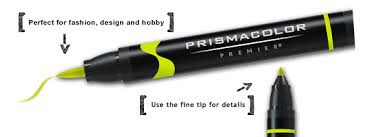 I haven't been to an art class in decades and I honestly have no idea what I'm doing here, so I decided to just have fun with it. I started by sketching in my design in pencil the way I wrote about last week. (This is the dirndl I'm planning on making.)
I haven't been to an art class in decades and I honestly have no idea what I'm doing here, so I decided to just have fun with it. I started by sketching in my design in pencil the way I wrote about last week. (This is the dirndl I'm planning on making.)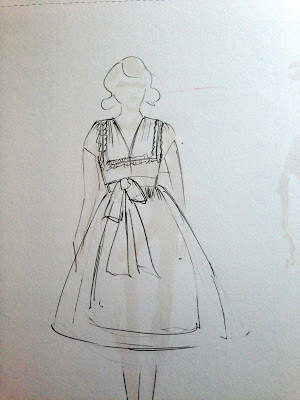 I know I plan on using this royal blue and black jacquard (from my new fall fabric collection, more to come on that!) so I had an idea what colors to use. I'm planning on finding a magenta silk for the apron and trim. I started by coloring in the apron and large parts of the dress, using the brush end of the marker. I drew black swirls on the dress to represent the jacquard pattern.
I know I plan on using this royal blue and black jacquard (from my new fall fabric collection, more to come on that!) so I had an idea what colors to use. I'm planning on finding a magenta silk for the apron and trim. I started by coloring in the apron and large parts of the dress, using the brush end of the marker. I drew black swirls on the dress to represent the jacquard pattern.
I drew in details and outlines with the fine point of a black marker. Then I experimented with making the blouse black and the lips red.

I didn't like the black blouse as much, but unfortunately there's no way to go back! (Though that's what sketching is for: now I know to buy white fabric for the blouse rather than black.) And I wasn't sure how to represent details like gathers on a black garment. (Ideas?) Ah well. Also important to note: the markers kind of seep through the paper, so you can only use one side.
Anyway, it's been a fun experiment. I'd love to hear your sketching tips! Do you work in color? What are your favorite techniques?
Published on September 23, 2015 06:32
September 21, 2015
Dirndls and "Wearability"
 Lena Hoschek Amalie Dirndl
Lena Hoschek Amalie DirndlAfter I wrote the post "Dirndl Mania," one of the comments expressed that while the dirndls were certainly cute, they are not wearable outside of maybe Oktoberfest. It's an intriguing comment, and I think the wearability factor probably depends on an intricate mix of geography, personal style, and the style of the dirndl itself.
I spent a few days in Southern Germany this summer and was surprised at how many women I saw walking around streets in dirndls. I figured that, given that I was largely in towns heavily visited by tourists, these were tour guides and employees of restaurants. However, in Regensburg, our tour guide was a young woman who shared some facts about typical dirndl wearing there. We passed a shop window which displayed mannequins wearing long dirndls.

The guide explained the significance of the dirndl, but said that women her age would almost never wear a long dirndl, that they preferred shorter ones that show more skin on the legs and cleavage. She also said that this demographic always has at least two dirndls: a "fun" one that's for "going out," and a "nicer" one for weddings and family celebrations. She said it was very common for a bride to request traditional dress at her wedding, meaning that girls and women would wear dirndls and boys and men would wear lederhosen. (I have to say that my fascination with this traditional dress has not extended to lederhosen. In Koblenz, I passed a bunch of drunken young men wearing lederhosen and it was like a terrifying gang of Overgrown Bavarian Manboy Frat Dudes. Little boys in lederhosen are always adorable though.) Interestingly, our tour guide also mentioned that lederhosen have become more popular for women to wear but that sometimes they veer toward the short and trashy (think Hotpants Lederhosen).
So, my limited experience on the matter tells me that if you live in Austria or Bavaria, dirndls are very much a part of a typical woman's wardrobe. But what if you live somewhere else and are in love with dirndls? Do you wear one once a year to your local Oktoberfest and that's that? That seems unsatisfactory. (Also, yesterday I went to the Bear Mountain Oktoberfest and was one of only 3 women wearing dirndls [see the other two below!]. I did see a woman wearing a t-shirt that read, 'This Is My Beer Drinkin' Shirt,' which was much more typical of the dress overall. Disappointing!)
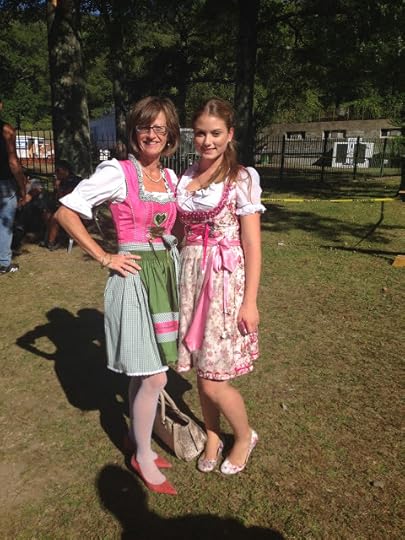
One question, to my mind, is how does a designer make dirndls more wearable to the rest of the world? What about the dirndl makes it "unwearable"? Is it the blouse? Some designers, like CocoVero, do a great job of adapting the dirndl in ways that make it more like a dress. Adding sleeves, for instance.
 CocoVero Dirndl
CocoVero DirndlDesigners like Julia Trentini make "dirndl dresses" or dirndlkleid which have sleeves and are more like '50s era shirtdresses than traditional dirndls. Julia Trentini's marketing copy even calls these dresses more "everyday" and mentions that they can be worn either with the apron (like a dirndl) or with a belt (like a dress).
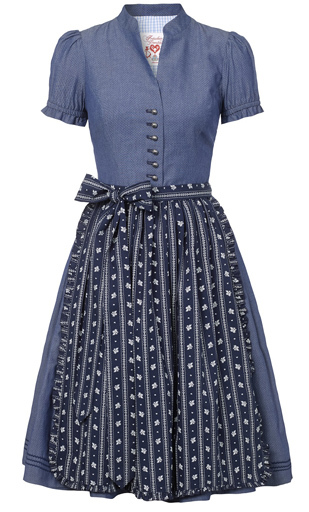 Julia Trentini Marta Dirndl Dress
Julia Trentini Marta Dirndl Dress Julia Trentini Traudi Dirndl DressWhich leads us to the apron. From my point of view, the one thing about dirndls that seems truly unwearable on a day-to-day basis is the apron. The rest of it is really a jumper and a blouse, and there are certainly ways to incorporate that into one's wardrobe. But the apron is perhaps the sticking point to the modern girl. One could wear the dirndl without the apron, though I know that's sacrilege in terms of traditional dress and custom. The designer in me also wonders if there's a way to hint at the apron: an overskirt or separate wrap skirt? For instance, this gorgeous Noh Nee dirndl suggests the line of the apron with the contrast fabric at the hem of the skirt and the sash at the waist. It could even be worn without the blouse.
Julia Trentini Traudi Dirndl DressWhich leads us to the apron. From my point of view, the one thing about dirndls that seems truly unwearable on a day-to-day basis is the apron. The rest of it is really a jumper and a blouse, and there are certainly ways to incorporate that into one's wardrobe. But the apron is perhaps the sticking point to the modern girl. One could wear the dirndl without the apron, though I know that's sacrilege in terms of traditional dress and custom. The designer in me also wonders if there's a way to hint at the apron: an overskirt or separate wrap skirt? For instance, this gorgeous Noh Nee dirndl suggests the line of the apron with the contrast fabric at the hem of the skirt and the sash at the waist. It could even be worn without the blouse.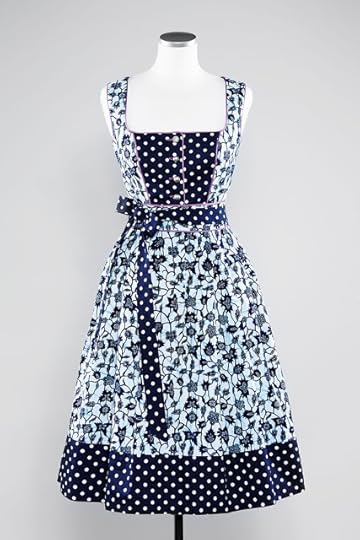 Noh Nee Tere Dirndl
Noh Nee Tere DirndlOf course, this entire debate this assumes that you care if something is wearable on a daily basis. Lots of stylish people, especially vintage-loving ones, wear things that the average person feels they can't "pull off."
What do you think? Is the dirndl wearable on a day-to-day basis? If not, are there ways to make it more wearable? Would you wear a dirndl without an apron?
Published on September 21, 2015 07:33
September 18, 2015
Dirndl Trim
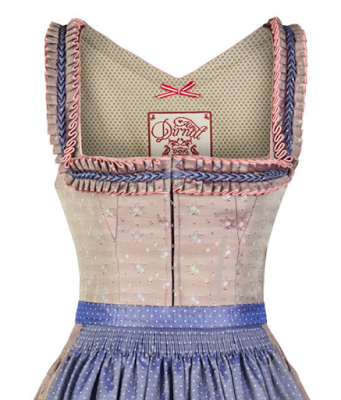 Lena Hoschek Röschen DirndlDirndl Fever is no where near subsiding! And it's just in time for Oktoberfest, so let's keep the dirndl posts rolling. One of the many reasons I am so attracted to dirndls is their beautiful craftsmanship. And that craftsmanship really shines in the use of gorgeous handmade trims. The Lena Hoschek dirndl above is one of my favorite examples: the trim around the neckline is a piped ruffle with handmade herzruche ("heart ruching") set in the center. That's an astounding amount of work, and the results are so lovely.
Lena Hoschek Röschen DirndlDirndl Fever is no where near subsiding! And it's just in time for Oktoberfest, so let's keep the dirndl posts rolling. One of the many reasons I am so attracted to dirndls is their beautiful craftsmanship. And that craftsmanship really shines in the use of gorgeous handmade trims. The Lena Hoschek dirndl above is one of my favorite examples: the trim around the neckline is a piped ruffle with handmade herzruche ("heart ruching") set in the center. That's an astounding amount of work, and the results are so lovely.Here's another Lena Hoschek design that uses just the herzruche around the neckline. The effect is stunningly simple.
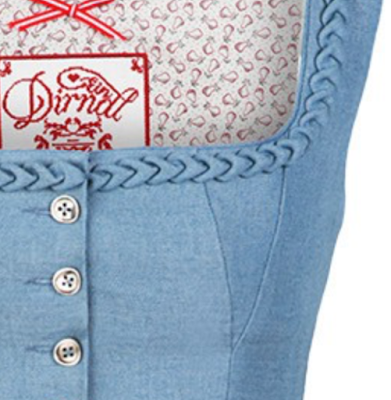 Lena Hoschek Kiritag Dirndl
Lena Hoschek Kiritag DirndlOther typical dirndl trims involved origami-esque hand pleating, like this Sonja Fellner design:

The subtly amazing thing about the trim above is the way the gingham side of the strip was cut a little wider than the red, so the gingham wraps slightly around to the red side. It's that kind of detail that blows my mind a bit.
I especially love designs that incorporate the contrasting apron fabric into the bodice trim.
 Lena Hoschek Cordula DirndlOf course, the question is: how does one learn how to make this type of trim? (Especially with no German language skills and only the beginnings of understanding of the subject.) A great resource I found is Folkwear pattern #123, which has several pages of instructions for making various types of dirndl trim.
Lena Hoschek Cordula DirndlOf course, the question is: how does one learn how to make this type of trim? (Especially with no German language skills and only the beginnings of understanding of the subject.) A great resource I found is Folkwear pattern #123, which has several pages of instructions for making various types of dirndl trim.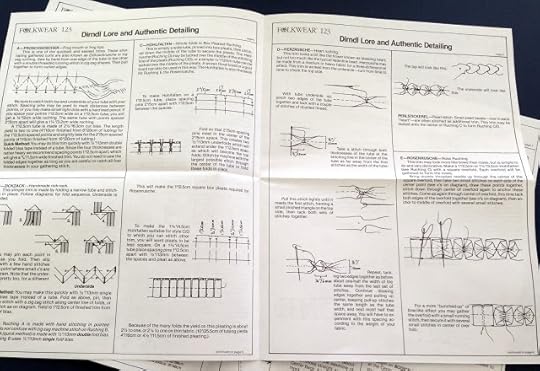
My vote for the best trim name? Froschgoscher, which is translated to "frog lips."
A good online resource for making ribbon herzruche is Kenneth King's article "How to Make Ribbon Trim." However, you will need a Threads Insider membership to view the entire thing. King, in his turn, recommends the book The Artful Ribbon by Candice Kling.
Other potential book resources (I say "potential" because I don't have them to look at) are Fabric Manipulation by Ruth Singer and The Art of Manipulating Fabric by Colette Wolff.
Readers, have you ever made your own dirndl trim? Do you have any resources to share?
Published on September 18, 2015 04:00
September 16, 2015
Dirndls and Boning
 Lodenfrey Dirndl, which uses boning at center front, concealing the hook and eye closureI've always loved the subject of adding structure to fitted vintage-style dresses. Boning, padding, underwires, underlining, interfacing, interlining: no topic is too minuscule or technical for me to obsess over! So when I caught Dirndl Fever in Germany recently, one of my first questions was about dirndls and boning. Since dirndl bodices are so fitted, it seems like using boning would be a common technique. However, I was surprised to find that the Hammerschmid dirndl I purchased in Passau has no boning in the bodice (though the entire outer layer is interfaced with what appears to be fusible Weft interfacing).
Lodenfrey Dirndl, which uses boning at center front, concealing the hook and eye closureI've always loved the subject of adding structure to fitted vintage-style dresses. Boning, padding, underwires, underlining, interfacing, interlining: no topic is too minuscule or technical for me to obsess over! So when I caught Dirndl Fever in Germany recently, one of my first questions was about dirndls and boning. Since dirndl bodices are so fitted, it seems like using boning would be a common technique. However, I was surprised to find that the Hammerschmid dirndl I purchased in Passau has no boning in the bodice (though the entire outer layer is interfaced with what appears to be fusible Weft interfacing).After buying my dirndl, I shopped again in a couple dirndl shops in Rothenburg specifically looking at the structure of the bodices. Evidence of boning was found! A few of the dirndls in the Pollinger shop had just two rows of boning, one on either side of the front zipper opening. The closest example I could find online was this Lodenfrey dirndl on eBay. See how there's a centered zipper with topstitching, and then two more rows of topstitching to either side of the zipper? The bones are inserted into the channels formed by the topstitching.
 SourceThis center front boning placement seems fairly common, and would be especially helpful if you were concerned about keeping the front opening of your dirndl sturdy and wrinkle-free (functioning like a busk on a corset). A few resources on this type of boning placement:
SourceThis center front boning placement seems fairly common, and would be especially helpful if you were concerned about keeping the front opening of your dirndl sturdy and wrinkle-free (functioning like a busk on a corset). A few resources on this type of boning placement:Here's a video on adding boning in the lining and at center front (though I would personally like to find a way to do this that hides the zipper tape between the outer fabric and the lining).Some very skillful dirndl sewing from a blogger, with incorporated center front boning. This Folkwear pattern incorporates optional center front boning.
I was curious if there were other ways of placing boning in a dirndl. Some more obsessive web searching brought me to Gössl, a traditional Austrian design house that seems to use boning much more liberally in their dirndl bodices. Bingo! Check out these photos.
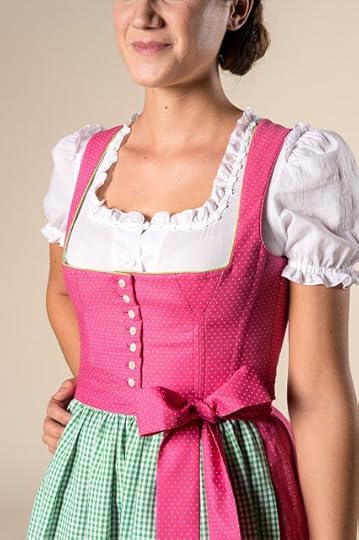 Source You can see a boning channel underneath the bust and then one that extends diagonally from the underarm to the waist.
Source You can see a boning channel underneath the bust and then one that extends diagonally from the underarm to the waist. SourceThese dirndls also have a line of boning on the back bodice. The back boning extends from the underarm to the waistline, near the side seam.
SourceThese dirndls also have a line of boning on the back bodice. The back boning extends from the underarm to the waistline, near the side seam.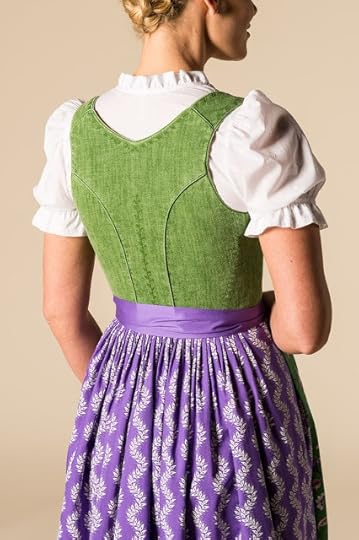 SourceIn these cases, it's interesting how the bones appear to be inserted into a stitched channel between the outer bodice and the lining, much like a corset.
SourceIn these cases, it's interesting how the bones appear to be inserted into a stitched channel between the outer bodice and the lining, much like a corset.On a side note, I went down some interesting rabbit holes with Google Translate. Gössl refers to their boning as miederstäbe, which translated back to me as "bodice rods." Lodenfrey uses the term formstäbchen, which Google translated as "shape chopsticks." Shape chopsticks! I love that! (On a side note to my side note, I obviously need to learn German if I'm going to really sew some dirndls.)
So readers, this is just a collection of my initial research into the use of boning in dirndls. All this said, it's also very common for dirndls not to use boning at all. I wrote to the kind ladies at Limberry (a site that carries some rather high-end designer dirndls), and they quickly wrote back saying the only designer they carry who uses boning in her dirndls is Sonia Fellner, whose designs incorporate a lot of corseting details.
 Sonja Fellner dirndl
Sonja Fellner dirndlNow, I know I'm not the only one out there who's spent time pondering this very subject. I would love to hear your experiences and thoughts on the matter of dirndls and boning, readers!
Published on September 16, 2015 11:18
September 14, 2015
Gertie Wears a Dirndl!
 Last week, I confessed my newfound love of all things Dirndl, and I wasn't surprised that you were all pretty enthused as well. What's not to love? Structured bodices, full skirts, puff sleeves, and so much more! I got a lot of requests to see pictures of me in my dirndl that I purchased in Passau, Germany. So here you go!
Last week, I confessed my newfound love of all things Dirndl, and I wasn't surprised that you were all pretty enthused as well. What's not to love? Structured bodices, full skirts, puff sleeves, and so much more! I got a lot of requests to see pictures of me in my dirndl that I purchased in Passau, Germany. So here you go!This is my "milk maid" pose.

The dirndl is by a brand called Hammerschmid and I picked it because it was made of natural fibers, wasn't too flashy or expensive, and I liked the color combination. The blouses are sold separately and I was surprised to learn that they end right underneath the bust, like a crop top. That seems to help reduce bulk and keeps things tucked in.
 The bodice doesn't have any boning, which seems fairly common. (Don't get me started right now. Oh readers, I have a whole post planned on the use of boning in dirndls.) However, the bodice does have fusible interfacing throughout and is fully lined in cotton so it has a substantial feel to it. The dress zips up the front and has a very snug fit.
The bodice doesn't have any boning, which seems fairly common. (Don't get me started right now. Oh readers, I have a whole post planned on the use of boning in dirndls.) However, the bodice does have fusible interfacing throughout and is fully lined in cotton so it has a substantial feel to it. The dress zips up the front and has a very snug fit.I love the hooks for the corset lacing--they're open at the top, making them a cinch to thread the ribbon through. Genius!
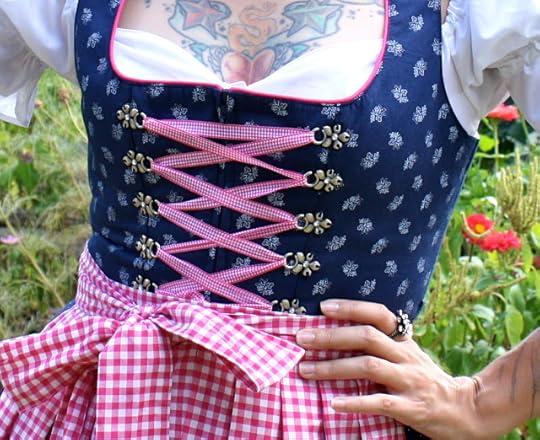
The bodice back has piped princess seams.
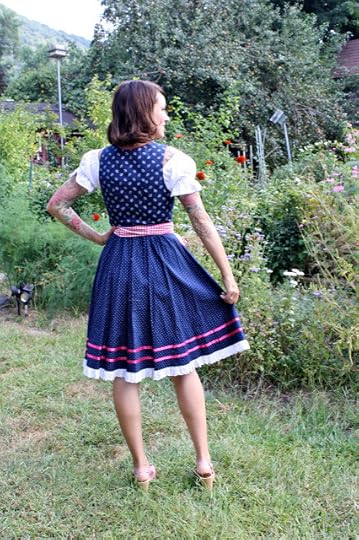 The skirt seems atypical in that it is flared, with no gathers in the front, and just light gathers in the back. My understanding is that a typical dirndl style is a rectangle shape with gathers or small pleats all over.
The skirt seems atypical in that it is flared, with no gathers in the front, and just light gathers in the back. My understanding is that a typical dirndl style is a rectangle shape with gathers or small pleats all over.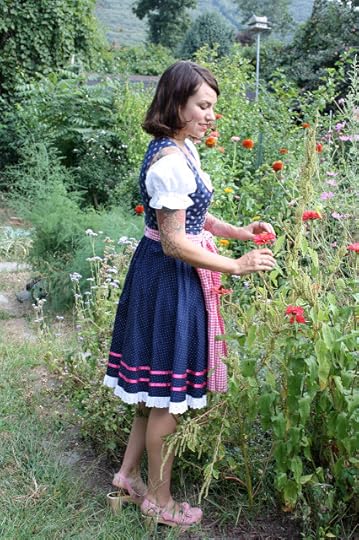 The gingham apron has large pleats rather than gathers or shirring, which is what I've noticed on more traditional aprons.
The gingham apron has large pleats rather than gathers or shirring, which is what I've noticed on more traditional aprons. A big thanks to my friend Melanie, who took these photos in her backyard, which I can almost make believe is in Austria somewhere! She also gave some great art direction having to do with "getting intimate" with the flower garden.
 Doesn't Mount Beacon look just like the Alps? Okay, maybe not.
Doesn't Mount Beacon look just like the Alps? Okay, maybe not. More dirndly fun to come!
More dirndly fun to come!
Published on September 14, 2015 04:00
September 10, 2015
Using Gertie's New Fashion Sketchbook
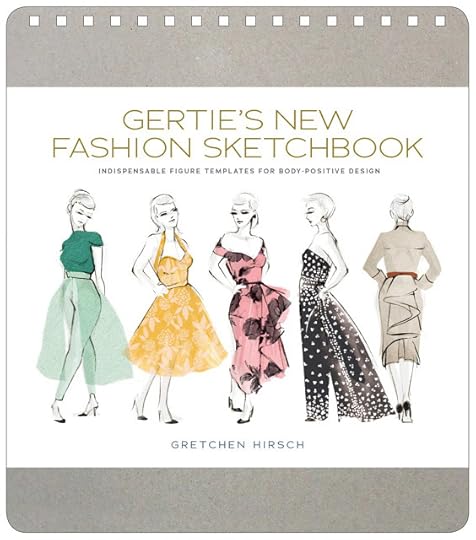
It's here! The sketchbook I mentioned in May, Gertie's New Fashion Sketchbook: Indispensible Figures for Body-Positive Design has been released. If you pre-ordered it, you should already have it in your little hands! The sketchbook provides croquis, or figure templates, that you can sketch your design ideas on top of. But what separates it from other books out there is that the figures have realistic height proportions (go feminism and body positivity!), and the light shaded figures are easy to customize according to your own body type.
First of all, the book is so pretty. When you take off the band, you'll see the metallic figures on the cover and a little spot where you can write in your name.


There's also text about sketching, how to represent your body type, and fashion through the decades. As always, brilliant illustrations by Sun Young Park!


When you'll get to the croquis, you might notice that they look really light. This is on purpose, as it helps you customize the figure more easily, and it also ensures that your sketching will stand out in the end, not the croquis. Make sure you have plenty of light. Use a regular or mechanical pencil, and begin to draw in the lines of your design. I decided on a dirndl, given my current obsession!

Continue the lines of the design, following the outer shaded areas of the croquis for larger proportions--and vice versa.

Draw in hair, if desired! I like to add a wavy bob (go figure). Lightly sketch in the lines of the arms, face, legs, etc. I don't really bother with facial features, I just sketch the lips and eyebrows usually.
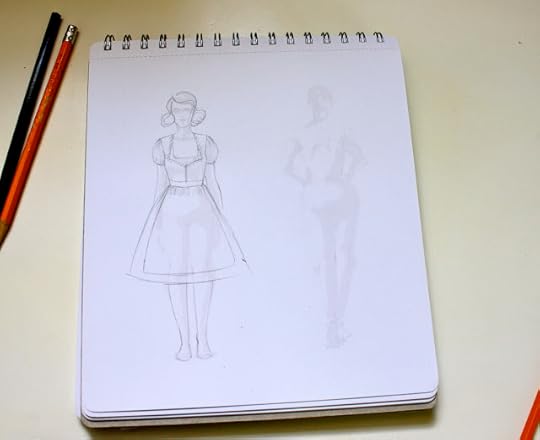
Add trims (like rick rack at the neckline), and sketch in the print of your fabric if desired. (The prints here are from my fabric line. Wouldn't this rose sateen be cute for a dirndl?)
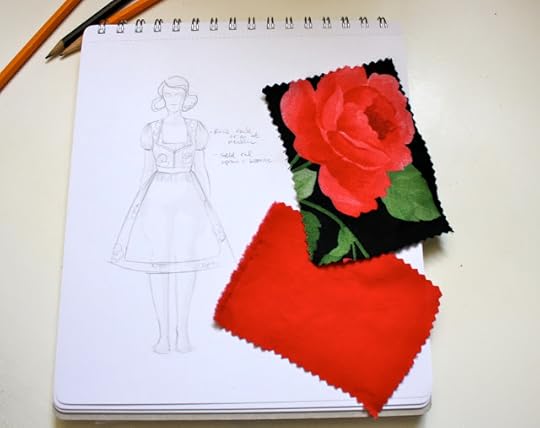
If you like your design, you can sketch the back too!

Here's a better example of customizing the figure. I drew a fitted dress, giving the model a high waistline and curvy hips. She also needed some Veronica Lake hair. (I started drawing in the cherries and got bored really quickly!)
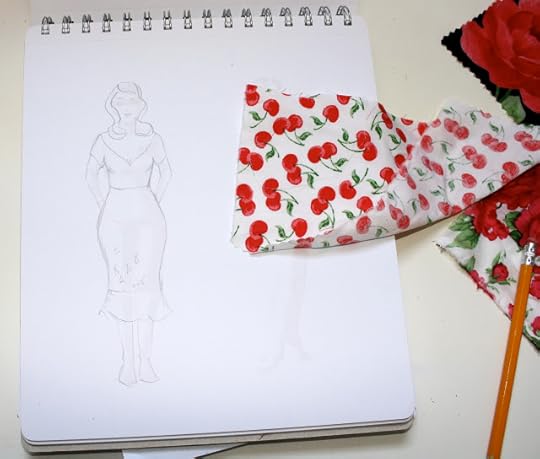
So there's a bit about using the sketchbook to draw your dream designs. I hope you'll share some of your sketches with me!
Published on September 10, 2015 04:00
September 8, 2015
Dirndl Mania
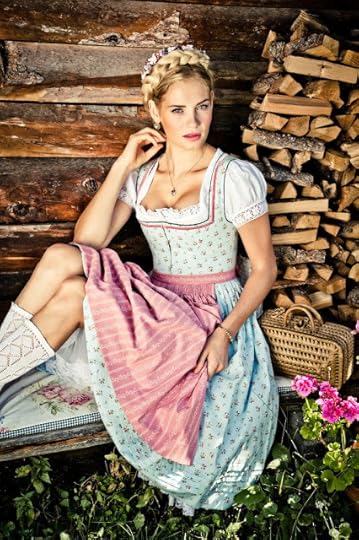 Lena Hoschek dirndlReaders, I've just returned from the most wonderful trip! My mom and I took a 17 day vacation in Europe. We started in Prague for three days and then took a river cruise from Budapest to Amsterdam. I'd never been to Europe before, and many people told me how inspirational I would find it. It certainly was, though I couldn't anticipate in what way. I didn't plan on any fabric or trim shops visits, or even anything vaguely fashion-related. My goal was just to experience the trip and see what came of it.
Lena Hoschek dirndlReaders, I've just returned from the most wonderful trip! My mom and I took a 17 day vacation in Europe. We started in Prague for three days and then took a river cruise from Budapest to Amsterdam. I'd never been to Europe before, and many people told me how inspirational I would find it. It certainly was, though I couldn't anticipate in what way. I didn't plan on any fabric or trim shops visits, or even anything vaguely fashion-related. My goal was just to experience the trip and see what came of it.The most significant thing that came of it, fashion-wise, was a deep and sudden love affair with the dirndl: the traditional costume of Austria and Germany. You probably already know this, but just in case: the dirndl is an ensemble which consists of a low-cut full-skirted dress with a snugly fitted bodice, an apron, and an underblouse that ends just below the bustline. Adorable jackets, flowered headbands, and hats may be added!
 Julia Trentini dirndl
Julia Trentini dirndl
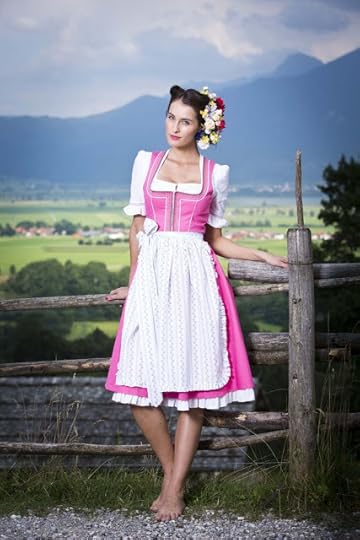 Julia Trentini dirndl
Julia Trentini dirndl
 Lena Hoschek dirndls and jacketsI first spotted a dirndl in Passau, Germany, when our tour guide was wearing one. I'd seen this type of costume in person before, but never on a day that wasn't October 31st, and not in such pretty fabrics. I was intrigued, but not yet smitten. I loved the corseted waistline and the little blouse she wore, but was somewhat turned off by the dowdy above-ankle length of her skirt and the overall costume-y effect of a tour guide wearing a folk costume. But then a curious thing happened. As I walked through Passau, I saw dirndls everywhere: on girls walking in the street, in shop windows, on mannequins on the sidewalks. They came in a lovely array of colors, patterns, and lengths (I immediately gravitated toward the "midi" dirndl, a very '50s just-below-knee length.)
Lena Hoschek dirndls and jacketsI first spotted a dirndl in Passau, Germany, when our tour guide was wearing one. I'd seen this type of costume in person before, but never on a day that wasn't October 31st, and not in such pretty fabrics. I was intrigued, but not yet smitten. I loved the corseted waistline and the little blouse she wore, but was somewhat turned off by the dowdy above-ankle length of her skirt and the overall costume-y effect of a tour guide wearing a folk costume. But then a curious thing happened. As I walked through Passau, I saw dirndls everywhere: on girls walking in the street, in shop windows, on mannequins on the sidewalks. They came in a lovely array of colors, patterns, and lengths (I immediately gravitated toward the "midi" dirndl, a very '50s just-below-knee length.) Mannequin outside a Pollinger dirndl shopI walked into a shop, determined to leave with a dirndl in hand, having developed a sudden and overwhelming need to possess one. I wanted one to study and admire and learn from. However, I was also deeply embarrassed by being an American tourist buying a traditional folk costume on a vacation, as well as being stymied by a language barrier. Could I pretend I was buying it as a gift? Not if I wanted it to fit, unfortunately. I conducted the whole shopping trip as if I were doing something illegal and didn't want to get caught. I quickly chose one I liked, a adorable deep blue and pink gingham design, and tried it on without bothering to take off my capri pants or sneakers. The first one didn't fit right (too big in the bust and waist), so I was forced to communicate with the salesgirl. She was equally dismayed by the roominess in the bodice, and brought me a smaller size. I zipped it up and it was like magic. The snug bodice did supernatural things to my décolletage, the little white blouse looked adorable peeking out of the neckline (much like a classic '50s shelf bust dress, I might add), and the gingham apron was perfect. It would be mine, readers. And then, almost as quickly as I had come in, I left, dirndl in hand!
Mannequin outside a Pollinger dirndl shopI walked into a shop, determined to leave with a dirndl in hand, having developed a sudden and overwhelming need to possess one. I wanted one to study and admire and learn from. However, I was also deeply embarrassed by being an American tourist buying a traditional folk costume on a vacation, as well as being stymied by a language barrier. Could I pretend I was buying it as a gift? Not if I wanted it to fit, unfortunately. I conducted the whole shopping trip as if I were doing something illegal and didn't want to get caught. I quickly chose one I liked, a adorable deep blue and pink gingham design, and tried it on without bothering to take off my capri pants or sneakers. The first one didn't fit right (too big in the bust and waist), so I was forced to communicate with the salesgirl. She was equally dismayed by the roominess in the bodice, and brought me a smaller size. I zipped it up and it was like magic. The snug bodice did supernatural things to my décolletage, the little white blouse looked adorable peeking out of the neckline (much like a classic '50s shelf bust dress, I might add), and the gingham apron was perfect. It would be mine, readers. And then, almost as quickly as I had come in, I left, dirndl in hand!Once back on board the ship, I started some real research on the current state of the dirndl. I discovered an entire world of amazing dresses by a slew of talented designers. I fell in love with the likes of Julia Trentini, Gossl, Lena Hoschek (whose more mainstream retro designs I already knew and loved), and Sportalm.
 Gossl DirndlI learned about the incredible beauty of a well-designed dirndl, the traditions and techniques that go into making one, and that a designer one can run you up to 1,500 Euros (and that's not even including the blouse!). I started pinning madly.
Gossl DirndlI learned about the incredible beauty of a well-designed dirndl, the traditions and techniques that go into making one, and that a designer one can run you up to 1,500 Euros (and that's not even including the blouse!). I started pinning madly.Follow Gretchen "Gertie"'s board Dirndls on Pinterest.
I'm not sure what's come over me, but I have fallen head over heels for dirndls: the dresses, the aprons, the fabrics, the jaunty feathered hats, the fitted little jackets, the fact that there are special dirndl bras to enhance that magical décolletage. Perhaps it is my German heritage coming out. Or the fact that there is a retro femininity to the whole look. Or maybe the whole world of dirndls is just something special and anyone who loves pretty handmade things would appreciate them in some way.
What is certain is that I will have a lot more to say on this subject, readers. I can't wait to share more dirndl love with you!
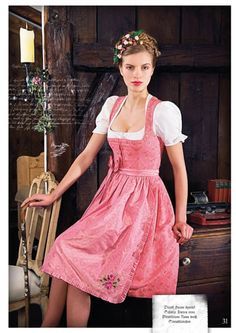 Julia Trentini Dirndl
Julia Trentini Dirndl
Published on September 08, 2015 11:23
August 3, 2015
The Daily Dress: '50s Nautical Rope Detail
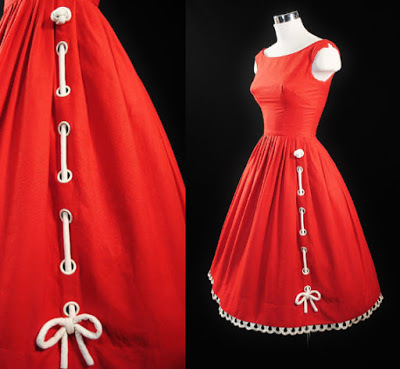 {source}Vintage dresses can be the best inspiration for unusual trims. Designers of the '50s in particular seemed to have a special knack for using basic trims in completely innovative ways. Take this cherry red dress for instance--how sweet is that that rope trim on the skirt? This design is by Mam'selle by Betty Carol, one of the "better Seventh Avenue junior labels."
{source}Vintage dresses can be the best inspiration for unusual trims. Designers of the '50s in particular seemed to have a special knack for using basic trims in completely innovative ways. Take this cherry red dress for instance--how sweet is that that rope trim on the skirt? This design is by Mam'selle by Betty Carol, one of the "better Seventh Avenue junior labels."And I think my favorite thing about it is how accessible it would be to reproduce. A basic red frock, scalloped lace trim, thick cord, and grommets: done! Large grommets are set vertically down the skirt. The cord is laced through with a chinese ball knot on one end and a bow on the other. That's it!
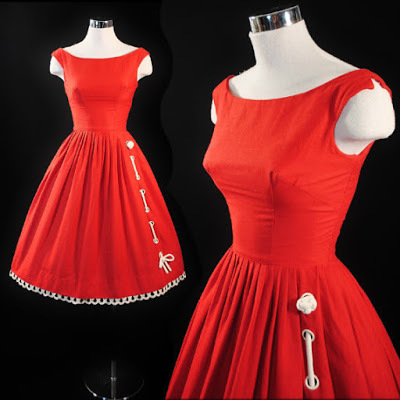
I love the idea of reproducing this dress with my pattern B6094 as the basis.
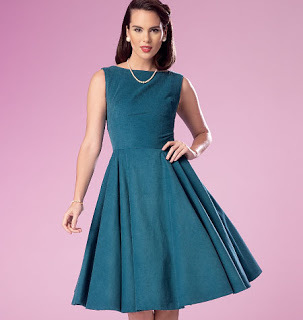
The back could even use more knot balls or bows on the flaps.
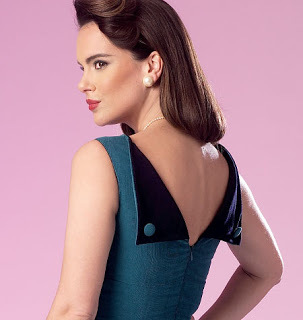 I haven't gotten to make this design for myself yet, and now I'm a little obsessed with the idea. Cherry red corduroy would be perfect!
I haven't gotten to make this design for myself yet, and now I'm a little obsessed with the idea. Cherry red corduroy would be perfect!
Published on August 03, 2015 04:00
July 10, 2015
Sewing Scenes: Magic Mike XXL
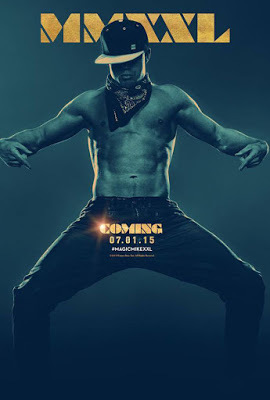 Well, there's a title I didn't expect to be writing! Life has been a little heavy lately, and I decided that going to see Magic Mike XXL was the perfect remedy. I went with a group of six rowdy ladies, which is really the only way to see this show. It was spectacular.
Well, there's a title I didn't expect to be writing! Life has been a little heavy lately, and I decided that going to see Magic Mike XXL was the perfect remedy. I went with a group of six rowdy ladies, which is really the only way to see this show. It was spectacular.I have a lot to say about this movie, starting with: sewing! There's a fabulous montage (God, I love a montage) where the ragtag bunch of "male entertainers" is getting ready for their big show, and it involves lots of DIY. There's a great little shot of a handheld sewing machine stitching along on a costume. These guys really do it all!
Of course, handheld sewing machines are notoriously terrible and there's no way an entire costume could be sewn on one in a pinch, but I'll suspend my disbelief.
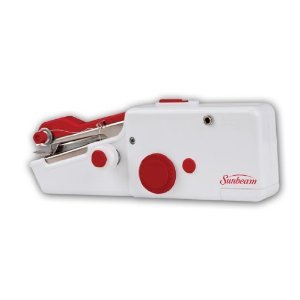 (Side note: the first Magic Mike also included sewing, with the perfect Joe Maganiello as "Big Dick" Ritchie sewing a gold thong.)
(Side note: the first Magic Mike also included sewing, with the perfect Joe Maganiello as "Big Dick" Ritchie sewing a gold thong.)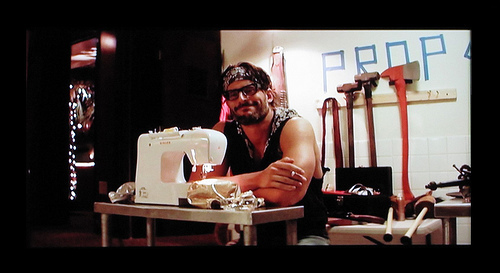 If you have any desire at all to see this movie: run, don't walk! to your nearest theater. Not only is it a big, campy male stripper road trip odyssey filled with lots of eye candy, it's an unexpectedly feminist film. There's tons that could be said about the politics of female sexual desire, but what's more striking is the politics of female happiness.
If you have any desire at all to see this movie: run, don't walk! to your nearest theater. Not only is it a big, campy male stripper road trip odyssey filled with lots of eye candy, it's an unexpectedly feminist film. There's tons that could be said about the politics of female sexual desire, but what's more striking is the politics of female happiness.These guys make it their mission to get their customers hot and bothered, for sure. But their primary goal in two instances is to get them to smile. There's a Joe Manganiello convenience store strip scene that will go down in history, the point of which is to get the dour cashier to grin. And he does! The crowd goes wild!

Which leads me to: male strippers are hilarious. They just are. They don't even have to try. I laughed my head off for two hours, as did my friends. Personally, I think that's the real secret to why women love this movie.
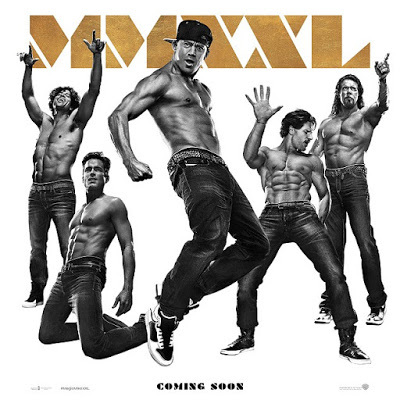
(Hey, I didn't say it was the only reason women love this movie.)
So, have you seen it? Will you? Please share your thoughts! The crafty feminist blogosphere needs to weigh in on this one.
Published on July 10, 2015 06:02
June 2, 2015
New Butterick Blouse Pattern
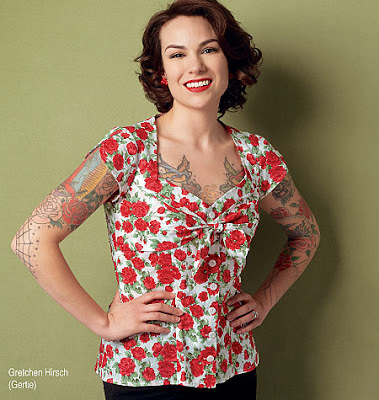 I have a new Butterick blouse pattern--and I'm on the pattern envelope and catalog cover! Since I've always done my own modeling for this blog and for my books, we decided to give it a try with my Butterick line too. This is B6217, a retro summer top with various design options.
I have a new Butterick blouse pattern--and I'm on the pattern envelope and catalog cover! Since I've always done my own modeling for this blog and for my books, we decided to give it a try with my Butterick line too. This is B6217, a retro summer top with various design options. 
Here it is on the real model.

And hey! Here I am on the envelope cover with the little illustrated ladies. (Speaking of which, how much do we love this Tumblr? So much.)
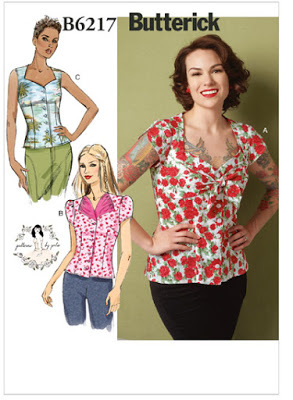 In other blouse news, here's a little video tutorial on It's Sew Easy TV for adding a back button extension to a blouse pattern. This uses the Portrait Blouse pattern from my first book and adds a little variation to it. You can use the technique with any pullover or side-zip blouse pattern though. The video is only up for the rest of the week, so watch it soon!
In other blouse news, here's a little video tutorial on It's Sew Easy TV for adding a back button extension to a blouse pattern. This uses the Portrait Blouse pattern from my first book and adds a little variation to it. You can use the technique with any pullover or side-zip blouse pattern though. The video is only up for the rest of the week, so watch it soon!
 I've appeared regularly on the PBS show It's Sew Easy over the years, but I've never actually watched it on TV! (I don't have cable, and it shows at different times in different states.) They release an episode on the website every week, so you can still watch it even if you don't get the show in your area!
I've appeared regularly on the PBS show It's Sew Easy over the years, but I've never actually watched it on TV! (I don't have cable, and it shows at different times in different states.) They release an episode on the website every week, so you can still watch it even if you don't get the show in your area!
Published on June 02, 2015 08:29
Gretchen Hirsch's Blog
- Gretchen Hirsch's profile
- 49 followers
Gretchen Hirsch isn't a Goodreads Author
(yet),
but they
do have a blog,
so here are some recent posts imported from
their feed.



